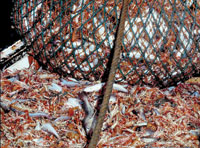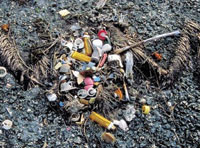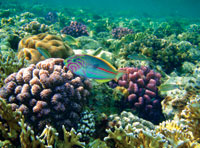From Sea to Not-so-Shining Sea
Mouth-watering seafood. Beach and water adventure. A convenient, vast waste dump. Oceans have provided us many things over the centuries, but we are pushing them beyond their limits.
Bottom line: Our oceans are stressed out.
Covering 70 percent of Earth, oceans provide oxygen, nutrients and wildlife habitat; break down waste; and help control climate. They are vital to life on Earth.
As environmental scientist David Suzuki says, “Our oceans are now threatened by the deadliest predator ever to appear on the planet, and that is us.”
Here’s a look at what’s going on in our oceans and how you can help.
PROBLEM: OVERFISHING
 What’s Happening: A food chain connects what eats what. Killing off too many of a single species within a chain can have a domino effect on all life. Because of its impact on marine food chains, overfishing by commercial fishermen might be the most destructive activity affecting the seas.
What’s Happening: A food chain connects what eats what. Killing off too many of a single species within a chain can have a domino effect on all life. Because of its impact on marine food chains, overfishing by commercial fishermen might be the most destructive activity affecting the seas.
Fish are being caught faster than they can reproduce, and an estimated 25 percent of what is caught is wasted. The catching of unwanted sea creatures that end up dying in nets is driving species to extinction.
What You Can Do: Make seafood choices that are good for the ocean. Download a Seafood Watch Pocket Guide from the Monterey Bay Aquarium at www.scoutlife.org/links/seafoodwatch.
PROBLEM: POLLUTION
 What’s Happening: Sewage, chemicals, oil, tons of garbage and more make their way into the ocean each year.
What’s Happening: Sewage, chemicals, oil, tons of garbage and more make their way into the ocean each year.
Pollutants such as fertilizers can cause giant algae blooms. These blooms suck up all the oxygen in the water, creating dead zones where life cannot exist.
Tides can carry pollution miles from its original source. As currents move garbage across the ocean, it collects into huge vortexes. These massive floating rafts of trash are largely made up of plastics that don’t break down: bags, containers, balloons, bottles, bottle tops, toothbrushes and packaging. One of the largest vortexes, located in the Pacific Ocean, is about the size of Texas.
These vortexes kill more than a million sea birds and 100,000 sea mammals and turtles each year. They either get tangled up and drown or eat the smaller plastics, which “resemble fish eggs, sea weed and other floating food,” explains Tracy McMullen of the South Carolina Aquarium. “Feeling full all the time, these animals with stomachs full of plastic eventually starve to death.”
What You Can Do:
- Buy organic. Wherever you live, fertilizers and pesticides used to grow food end up in the ocean. Buying organic helps keep these poisons out of the water cycle.
- Look for hazardous waste disposal sites in your community to properly get rid of paints, oils, chemicals and batteries (www.scoutlife.org/links/earth911).
- Reduce, reuse and recycle to help keep garbage out of the ocean.
PROBLEM: GLOBAL WARMING
 What’s Happening: Warmer water is melting Arctic sea ice. Phytoplankton, the base of most aquatic food chains, depends on sea ice to bloom. When there’s less sea ice, there’s less phytoplankton.
What’s Happening: Warmer water is melting Arctic sea ice. Phytoplankton, the base of most aquatic food chains, depends on sea ice to bloom. When there’s less sea ice, there’s less phytoplankton.
Less phytoplankton will affect the food chain, all the way up to humans. “Many scientists now think Arctic sea ice will be completely gone in 30 years,” says former Scout Jake Levenson of the International Fund for Animal Welfare.
“Changes in sea ice will have profound effects not only for Arctic animals like seals and polar bears, but on the seasonal krill population, too. Krill (which feed on phytoplankton) form the base of much of the food chain around the world. Less of it means less food for whales and just about all the fish we buy in the supermarket.”
Also, melting polar ice caps and glaciers are causing rising sea levels. By 2100, they could rise by as much as 35 inches. That’s about five times more than sea level changes over the past 100 years. Possible results? Coastline damage and flooding in coastal and low-lying cities.
What You Can Do: Help cut down greenhouse gases by walking, biking or skateboarding to school instead of driving. Turn off lights, computers, TVs and game consoles when you’re done.
PROBLEM: DYING CORAL REEFS
 What’s Happening: Climate change is putting coral reefs at risk. These “rain forests of the sea” provide habitat for nearly 25 percent of all marine life: fish, sponges, lobsters, crabs, starfish, sea turtles, sea snakes and more. Loss of reefs means loss of species diversity.
What’s Happening: Climate change is putting coral reefs at risk. These “rain forests of the sea” provide habitat for nearly 25 percent of all marine life: fish, sponges, lobsters, crabs, starfish, sea turtles, sea snakes and more. Loss of reefs means loss of species diversity.
Warmer water is increasing diseases in corals and stifling their growth. At the same time, excess carbon dioxide in the atmosphere is also making the oceans more acidic, which is harmful to animals with chalky skeletons such as coral. Their skeletons stop developing, and it is their skeletons that form the coral reefs.
Other reef threats: overfishing, pollution and coastal development. And you don’t have to live near the coast to affect reefs. Since much of our continent’s water drains into the Gulf of Mexico, “what inland residents do to their water supply can impact coral reefs from Texas to Mexico to Florida and beyond,” says Scouter Kelly Drinnen of Flower Garden Banks National Marine Sanctuary.
What You Can Do:
- Make sure only human and food wastes are flushed down the toilet, not harmful chemicals.
- Use nontoxic cleaning products to ensure poisons and other chemicals aren’t washed down the drain.
- Get active in programs to protect oceans and coasts, such as International Coastal Cleanup Day on Sept. 20 (www.scoutlife.org/links/oceanconservancy) and International Year of the Reef events.
Great article; thanks for the science!
love it
In response to Boomer, above – I don’t think the author used the term “global warming”, but rather the universally accepted term amongst the scientific community of “climate change” – which implies both positive and negative changes in the earth’s climate. And in response to Al – your comment had me wondering about the facts in this article, so I researched them and couldn’t find any that were incorrect – this is definitely not “goop” or lunatic writing at all. David Suzuki has indeed called humans the “deadliest predator” in several online and in-person interviews.
i love it
it is so cooi
how did this goop get on to the Boy’s Life website? Do they verify anything before putting it on the site? Seafood choices that are good for the Sea!!!! David Sazuki calls us the deadliest predator??? We are as much a part of Nature as anything in it. This is just crazy lunatic writing… Is anybody watching the hen house?
While we all need to do our share to preserve our environment, current global warming, especially manmade is highly debatable. Your article seems to take global warming as fact, however as many as 3100 scientists disagree with this, a fact not mentioned in your article. Also a 2007 study by NASA, RSS, etc (www.dailytech.com) show global temps have dropped 0.65C – 0.75C over the last year, a value large enough to wipe out all global warming over the past 100 years, all in 1 years time. It’s the single fastest temp change ever, up or down. Please try to be more objective and mention facts on both sides of this arguement. Our sons need to know ALL the facts, not just what is PC! Thanks!